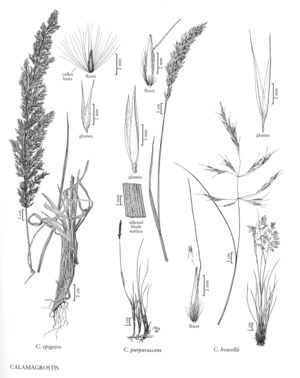Difference between revisions of "Calamagrostis howellii"
FNA>Volume Importer |
imported>Volume Importer |
||
| (4 intermediate revisions by 2 users not shown) | |||
| Line 1: | Line 1: | ||
{{Treatment/ID | {{Treatment/ID | ||
|accepted_name=Calamagrostis howellii | |accepted_name=Calamagrostis howellii | ||
| − | |accepted_authority= | + | |accepted_authority= |
|publications= | |publications= | ||
|common_names=Hovell's reedgrass | |common_names=Hovell's reedgrass | ||
| + | |special_status={{Treatment/ID/Special_status | ||
| + | |code=E | ||
| + | |label=Endemic | ||
| + | }} | ||
|basionyms= | |basionyms= | ||
|synonyms= | |synonyms= | ||
| Line 17: | Line 21: | ||
-->{{Treatment/Body | -->{{Treatment/Body | ||
|distribution=Oreg.;Wash. | |distribution=Oreg.;Wash. | ||
| − | |discussion=<p>Calamagrostis howellii grows on dry rocky slopes, banks, ledges, and in cliff crevices, sometimes on basalt, from 100-500 m. It grows only in the Columbia River Gorge of Washington and Oregon.</p> | + | |discussion=<p><i>Calamagrostis howellii</i> grows on dry rocky slopes, banks, ledges, and in cliff crevices, sometimes on basalt, from 100-500 m. It grows only in the Columbia River Gorge of Washington and Oregon.</p> |
|tables= | |tables= | ||
|references= | |references= | ||
| Line 26: | Line 30: | ||
-->{{#Taxon: | -->{{#Taxon: | ||
name=Calamagrostis howellii | name=Calamagrostis howellii | ||
| − | + | |authority= | |
| − | |authority= | ||
|rank=species | |rank=species | ||
|parent rank=genus | |parent rank=genus | ||
| Line 33: | Line 36: | ||
|basionyms= | |basionyms= | ||
|family=Poaceae | |family=Poaceae | ||
| − | |illustrator=Cindy Roché | + | |illustrator=Cindy Roché;Hana Pazdírková |
| + | |illustration copyright=Utah State University | ||
|distribution=Oreg.;Wash. | |distribution=Oreg.;Wash. | ||
|reference=None | |reference=None | ||
|publication title= | |publication title= | ||
|publication year= | |publication year= | ||
| − | |special status= | + | |special status=Endemic |
| − | |source xml=https:// | + | |source xml=https://bitbucket.org/aafc-mbb/fna-data-curation/src/200273ad09963decb8fc72550212de541d86569d/coarse_grained_fna_xml/V24/V24_1004.xml |
|subfamily=Poaceae subfam. Pooideae | |subfamily=Poaceae subfam. Pooideae | ||
|tribe=Poaceae tribe Poeae | |tribe=Poaceae tribe Poeae | ||
Latest revision as of 16:21, 11 May 2021
Plants sometimes with sterile culms; usually densely cespitose, occasionally with rhizomes shorter than 1 cm. Culms (25)35^45(60) cm, unbranched, smooth or slightly scabrous beneath the panicles; nodes 1-2. Sheaths and collars smooth; ligules (2.5)3.5-6 mm, acute, lacerate; blades (9)12-20(25) cm long, 1-2.5(3) mm wide, flat to involute, abaxial surfaces smooth, adaxial surfaces finely scabrous, glabrous or sparsely hairy. Panicles (5)7-12(15) cm long, (2)3.5-6.5(8) cm wide, loose, open, straw-colored or green to purplish; branches (2)3.5-5(7) cm, smooth or sparsely scabrous, spikelets usually confined to the distal 1/2. Spikelets (5.5)6-8 mm; rachilla prolongations 1-1.5(2) mm, hairs (1.5)2-2.5(3) mm. Glumes rounded to slightly keeled, smooth or scabrous distally, lateral veins usually prominent and raised, apices acuminate; callus hairs 2-3(4.5) mm, 0.4-0.6(0.7) times as long as the lemmas, abundant; lemmas 4.5-5 mm, about 2 mm shorter than the glumes; awns (10)13-16 mm, attached to the lower 1/5 – 2/5 of the lemmas, exserted, stout, easily distinguished from the callus hairs, strongly bent; anthers (2)2.5-3(4) mm. 2n = 28.
Discussion
Calamagrostis howellii grows on dry rocky slopes, banks, ledges, and in cliff crevices, sometimes on basalt, from 100-500 m. It grows only in the Columbia River Gorge of Washington and Oregon.
Selected References
None.
